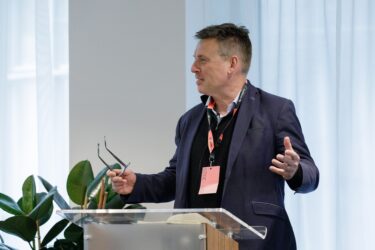
Listen in to this conversation between Jake Lipton, Partner at Wallbrook, and Barrett Lawson, Director at Anthesis, as they provide valuable insights into the key takeaways and trends discussed during Climate Week NYC 2023.
They touch upon various topics such as the need for more rigorous ESG due diligence processes, the challenges and importance of setting the right metrics for sustainability-linked loans, and the evolving regulatory landscape. The conversation also highlights the growing importance of collaboration and cooperation, particularly in the credit space, as well as the need for value-driven ESG practices. They emphasize the significance of understanding the specific positions of LPs and framing ESG topics effectively to navigate stakeholder pressures.
Additionally, the discussion underscores the importance of making ESG initiatives real on the ground and how the exit phase of investments represents an area with untapped potential for value creation. Overall, this conversation offers valuable insights for those interested in the evolving landscape of ESG and climate-related investments, making it worth watching in its entirety.
Jake: Pleased to be sitting here with my colleague Barrett Lawson, who heads our work for financial sponsors and private equity clients. So, as we sit here in the New York office on Friday, after Climate week, we thought it would be nice to share a few impressions of your experience and any major takeaways that you have after having the opportunity to speak with a number of clients and attend a few events. So, I guess the question is to you Barrett, what are some of the broader themes and feedback that you’ve been hearing in your conversations with clients over the past week and how does that translate into the work we’re doing as we look to position our offerings in this space?
Barrett: Yeah, so I think a few things stood out from the conversations. One was that we had a lot of clients talking about revisiting their ESG due diligence process, looking to drive more rigor through that and more value rather than a check the box exercise. So, thinking through how do they take the output from diligence and use that in a really meaningful way to get into the value creation and the strategy and the actions that they’re going to take during ownership.
So that was one common theme. We heard another one; we spoke with a lot of folks that are active in the credit space, and it really feels like sustainability-linked loans, green loans are a big focus for people, but there’s still a lot of concern around setting the right metrics associated with them, the right data points, getting that data, making sure it’s robust, and then being able to check on that data over time in a way where there’s confidence in the information.
Jake: Yeah, that’s really interesting. Do you feel like in the conversations we’ve been having, particularly on the credit side, that there is a fair amount of cooperation and collaboration in that sector similar to historically how there has been on the equity side? Or do you think that as things evolve and as market conditions ultimately dictate, how investors will look to create value, value that work still needs to be done on the credit side to build a similar sort of community, broad based recognition of what applicable and acceptable ESG standards are?
Barrett: Yeah there’s no doubt that credit is farther behind where buyout is, but there’s definitely a lot of common needs and a lot of folks that are working together to try and solve those issues. And in many cases those same organizations are working in both spaces, so a lot of those connections and collaboration points already exist. It’s just refocusing in on what’s happening with credit.
How about you? What are some of your takeaways from talking with clients over Climate Week?
Jake: I think one of the things that has jumped out at me is on the ESG side, and particularly on more of the governance and social related components of those, work streams, which traditionally are harder to measure, harder to quantify, there’s a seemingly evolution from a disclosure based regime, where it’s about identifying risks and figuring out where in terms of your assets or your suppliers, there might be opportunities to address them, to more of a regulatory regime where the onus is on either the investor or the port code to interrogate the quality of the data, the quality of the information that’s coming from companies to ensure it accurately reflects the realities on the ground and the risks on the ground.
So as we move into that environment, particularly in Europe there will be an increase on portfolio companies and asset owners to really corroborate and verify information. And one way to do that is by going on the ground, by speaking with local stakeholders by measuring things that you can’t really do behind a computer screen necessarily, but are you getting out into the world and consulting with experts? Not only depending on what the sector is, but also in the jurisdiction, let’s say a place like Brazil where there’s huge intersectionality between risks of biodiversity and land usage and labor rights. But that doesn’t mean there’s not opportunity there as well.
So I really think things are evolving towards a framework that is going to require just a deeper level of verification as folks seek to do this responsibility, have an impact that scale.
Barrett: The regulatory piece was something that came up in a lot of the conversations. Something keeping clients up at night worrying about another one that was a common concern and something that folks are thinking about is the evolving stakeholder pressures and pressures from LPs on those that are very much pro ESG and pushing to see more action and those now that are anti ESG and how to navigate those conflicting forces.
I think a lot of folks feel like they’re sort of stuck between a rock and a hard place, but the common theme I heard there was really if as long as the ESG work, however it’s termed is grounded in value creation and solid investment practices then folks feel like they’re on a much more solid ground.
Jake: Yeah. I think that’s absolutely rings true. And we’d be interested in starting to unpack what specifically you’ve historically done and what you can do to help clients navigate that tricky dynamic where there are outside forces that are going to be scrutinizing them, whichever side of the fence they fall on. What’s important for them to keep in mind as they seek to chart a course that ultimately is acceptable to their stakeholders, but also does not put them under the microscope in ways that they might not want to be?
Barrett: I think the first thing to do is really get an understanding of the positions of your specific LP base. It’s easy to talk about LPs as a monolithic group, but different organizations have different exposures and understanding how much value is at stake, that’s pushing in certain directions is step one. And then as I mentioned before, focusing on value creation. Potentially thinking about the language that is being used to communicate topics and how it’s being framed, those types of things are important to consider as the next step.
Jake: Is there anything that, particularly spending time in New York over the past week jumps out of you as a next step, whether it’s implementing solutions or doing certain things that haven’t been done before, where do you think folks like us can help our client base build awareness and really drive impact?
Barrett: Well, it really feels now with the being here in Climate Week and a lot of the focus on Climate week has been actually getting out doing it and making this real. And it feels like we’re at that point where it needs to become real very quickly. And so folks are some of the key challenges are going to be around implementing, actually getting out, getting the data, working with portfolio companies in a hands-on way to drive to drive change if they have an equity stake. If it’s on the credit side, it’s about maybe a little bit less hands-on, but being a resource and positioning those companies to be successful in achieving some of the metrics that you’ve set out for impact.
So it’s really about getting out there and making things real on the ground.
Jake: Yeah, and I think one of the things that jumps out at me as well as we talk about ways to help is it’s really throughout the life cycle of an investment. So, there’s a prospecting phase, there’s the pre-acquisition phase, and then there’s the operations phase, and then obviously exit phase. As we’re thinking about the credit side and as we’re thinking about other trends on the equity side as well, which of those phases do you think is more underdeveloped relative to other phases in that total lifecycle?
Barrett: That’s a great way to position it. My feeling is it’s the exit especially as managers are thinking more about ESG as a value creation play. The exit is where you drive that value and being able to tell the story effectively to the next buyer and position the company in the best way possible from an ESG standpoint to highlight all the work that you’ve done and drive that return on the hard work that’s been done during the ownership phase. That really feels like a big unlock that I think many managers are beginning to work on, but there’s still opportunity to blow out further.
Jake: It strikes me as one of those areas where given progress made on ESG and climate reporting and disclosures in the past five to 10 years, there’s just not a whole lot of precedent on how to do that well, and there’s not necessarily a playbook, although there is one emerging. So I think particularly for us, that’s an exciting area of development because there is the chance to establish that precedent, right aspects of the playbook to show responsible operators and financial sponsors how to do this in a way that ultimately not only drives value, but show evidence of creating value. But also do it in a way that is ultimately respectful and lives up to the commitments you made throughout not only at the start of the deal, but throughout your ownership of that asset as well. So it’s like now things are coming full circle that really does strike a chord with me as one way in which your team and our teams together are well positioned to help write that story.
We are the world’s leading purpose driven, digitally enabled, science-based activator. And always welcome inquiries and partnerships to drive positive change together.



